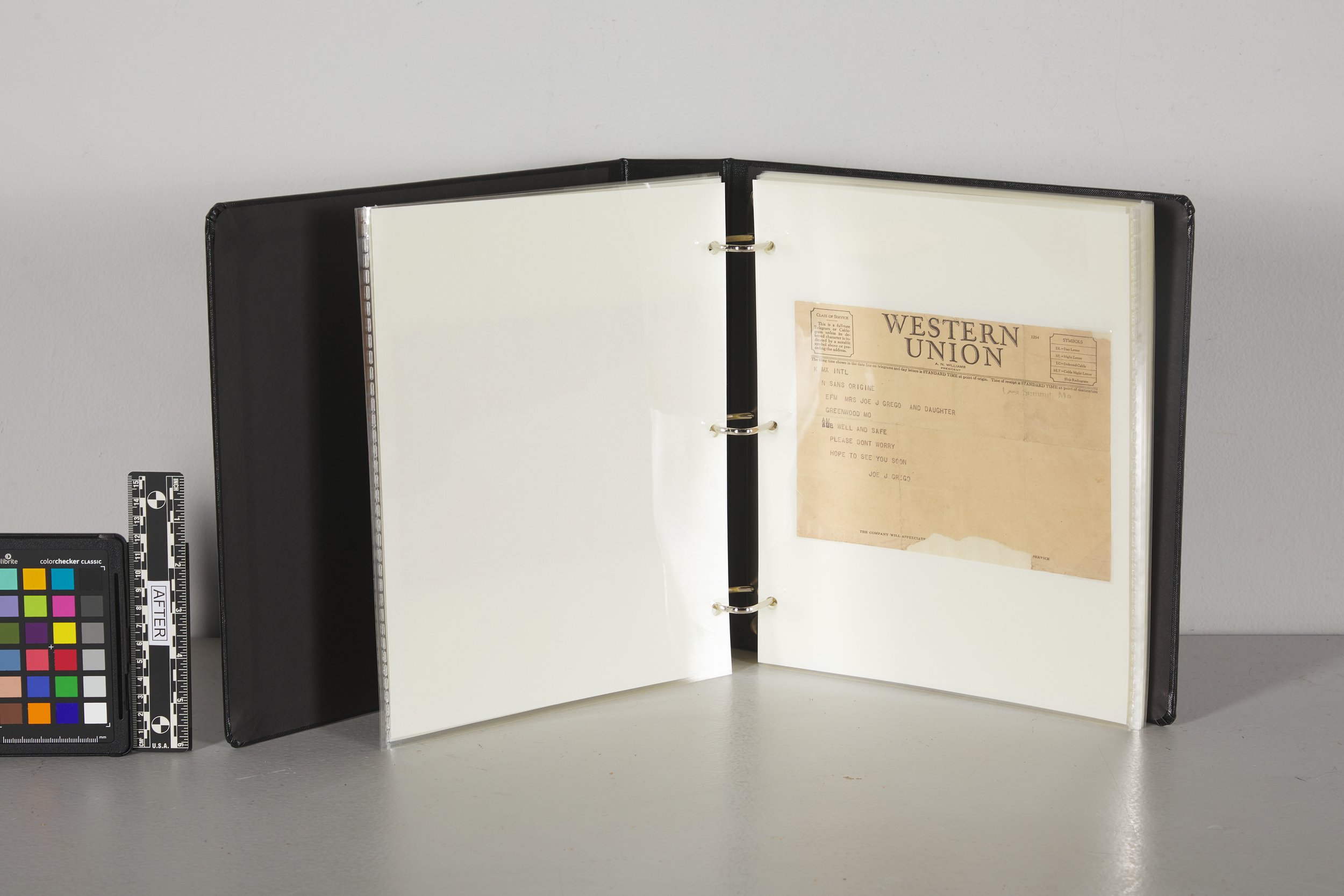Every so often, we get the chance to work on an incredibly sentimental and historically important heirloom brought in by one of our very own staff members. This collection of eight telegrams, two letters, three notes, and one photograph belonged to one of our team members' great-great grandfather and traces his time in the service during World War II.
The documents prior to treatment.
The documents prior to treatment.
Mr. Joe J. Grego was drafted in his late 20s to early 30s, when his daughter was just 4 years old. He went to basic training and then was immediately sent to the beaches of Normandy, just two or three days after the D-Day invasion. “He was really lucky in that way, and we’re lucky too, really, because he could very well not be here and we could not be talking about this,” said the father of our staff member in an interview.
“The story he told me -- I asked him what was it like being over there, and the first words out of his mouth were nobody wanted to be there. But we had to,” he continued. “There was no way around it -- you had to be there for what was going on in the world. But we went there, we did our job, and luckily most of them that I was with came home.”
Mr. Grego stands in uniform, fourth from the left.
If only it were that easy for Mr. Grego. He didn’t like talking about his time in the war, a sentiment shared by many Veterans. One memory must have been particularly difficult: his time spent as a prisoner of war.
He was captured in Germany after getting shot by a sniper. A somber telegram from November 21st, 1944, informs Mrs. Grego that “your husband, Private First Class Joe J. Greco has been reported missing in action since six November in Germany.” A handwritten letter from Mr. Greco to his “two sweethearts” confirms that he was captured as a prisoner of war, but he was “feeling fine and treated OK.” (A man with a sweet tooth, he then urges his wife to contact the Red Cross to send “3 almond Hershey bars, and any other sweets or things to eat.”)
The telegram sent to Mrs. Grego informing her that her husband was missing.
Mr. Grego was not returned to the control of the United States military until several months later; Mrs. Grego was informed of the news via a telegram she received on May 26th. The details of the months in between are largely unknown, although he did share that the worst part of his time in captivity was the forced marches as the Allies began to close in, and the frostbite that resulted from the bitter cold.
His journey home was not direct, and he sent messages to his wife along the way as he grew closer. Upon his return, he left the military and dedicated his life to civil service. He received a Purple Heart and several other accolades for his sacrifices.
Towards the end of his life, he became increasingly involved with the local VFW, growing especially close with the other former POWs. They were all in attendance at his funeral, where he was honored with a military salute.
“He was a good man,” said our staff members’ father. “Very generous with his entire family and liked to take care of people.”
His family collected and kept documents related to his military service, recognizing their intrinsic value. We were honored to have several of these documents brought to us at The Conservation Center, where our Paper conservators were able to preserve them for years to come.
The pieces exhibited moderate distortion throughout the sheets with scattered handling dents, small losses, and tears on several items. The paper pieces and photograph showed inherent age-related discoloration and the telegrams have yellowed. Six of the paper items were mounted to magnetic album pages that were still tacky. Each item had a light layer of surface soiling.
Carefully handling a telegram during treatment.
Knowing the importance of these heirlooms, our team quickly got to work. The pieces were photographed for in house documentation before and after conservation treatment. The telegrams mounted on the magnetic album pages were mechanically separated from the page with a smooth Teflon spatula. The items were surface cleaned using textile sponges and a soft brush to reduce surface soiling. To reduce the distortion and creasing each item was passively humidified in a Gor-tex humidification chamber and flattened between blotters under weights. The tears and losses were repaired with thin Japanese tissue and wheat starch paste. The paper pieces were treated with a non-aqueous deacidification spray to introduce an alkaline reserve into the paper.
The collection of items was then rehoused onto new archival album pages with mylar photo corners. The new album pages also each had a mylar sleeve to protect the album page and items. An archival binder was recommended to house the new album pages. They are now securely back in the hands of our staff members family, a tribute to the memory of Mr. Joe J. Grego.
The documents in an archival binder, after treatment.







